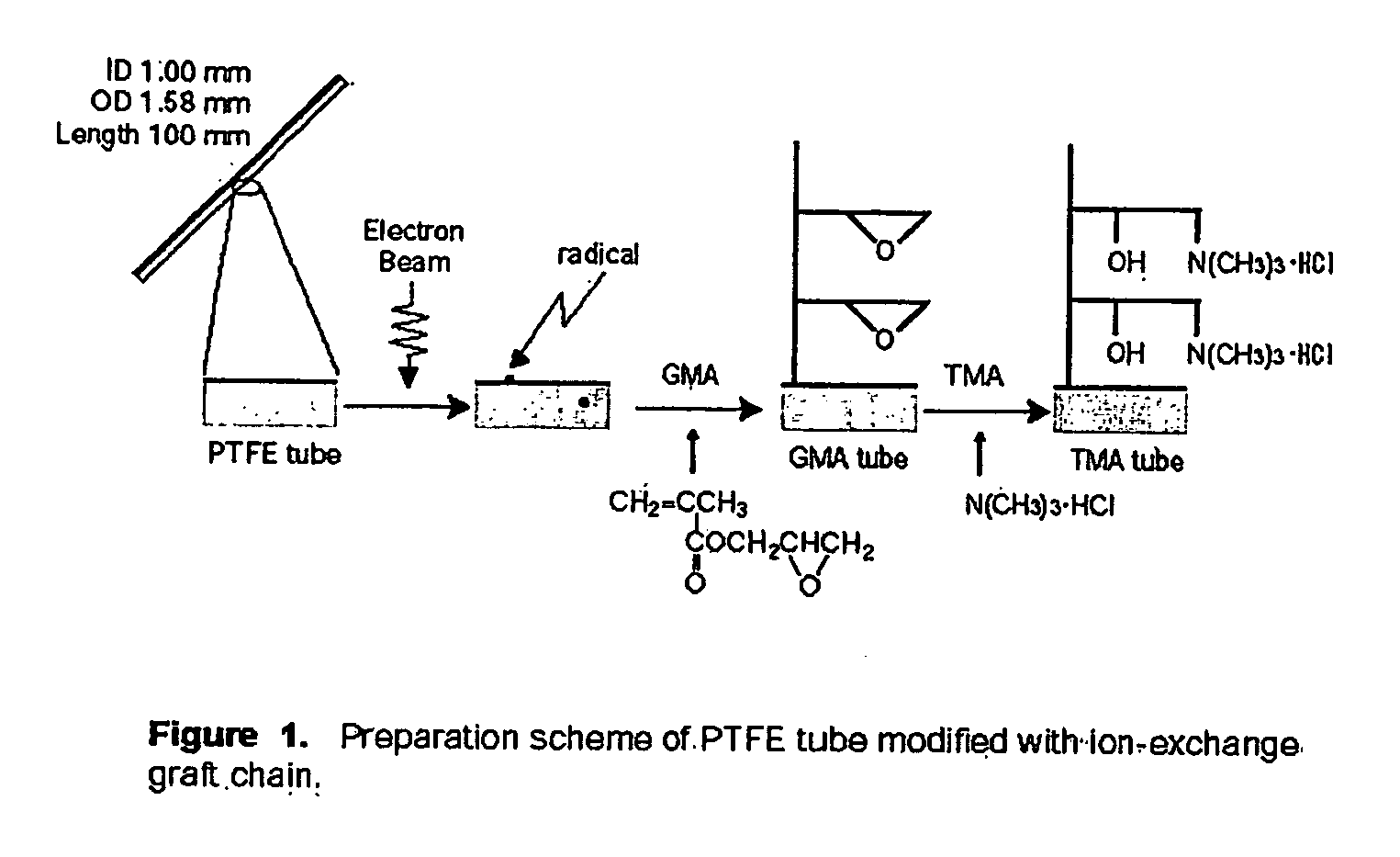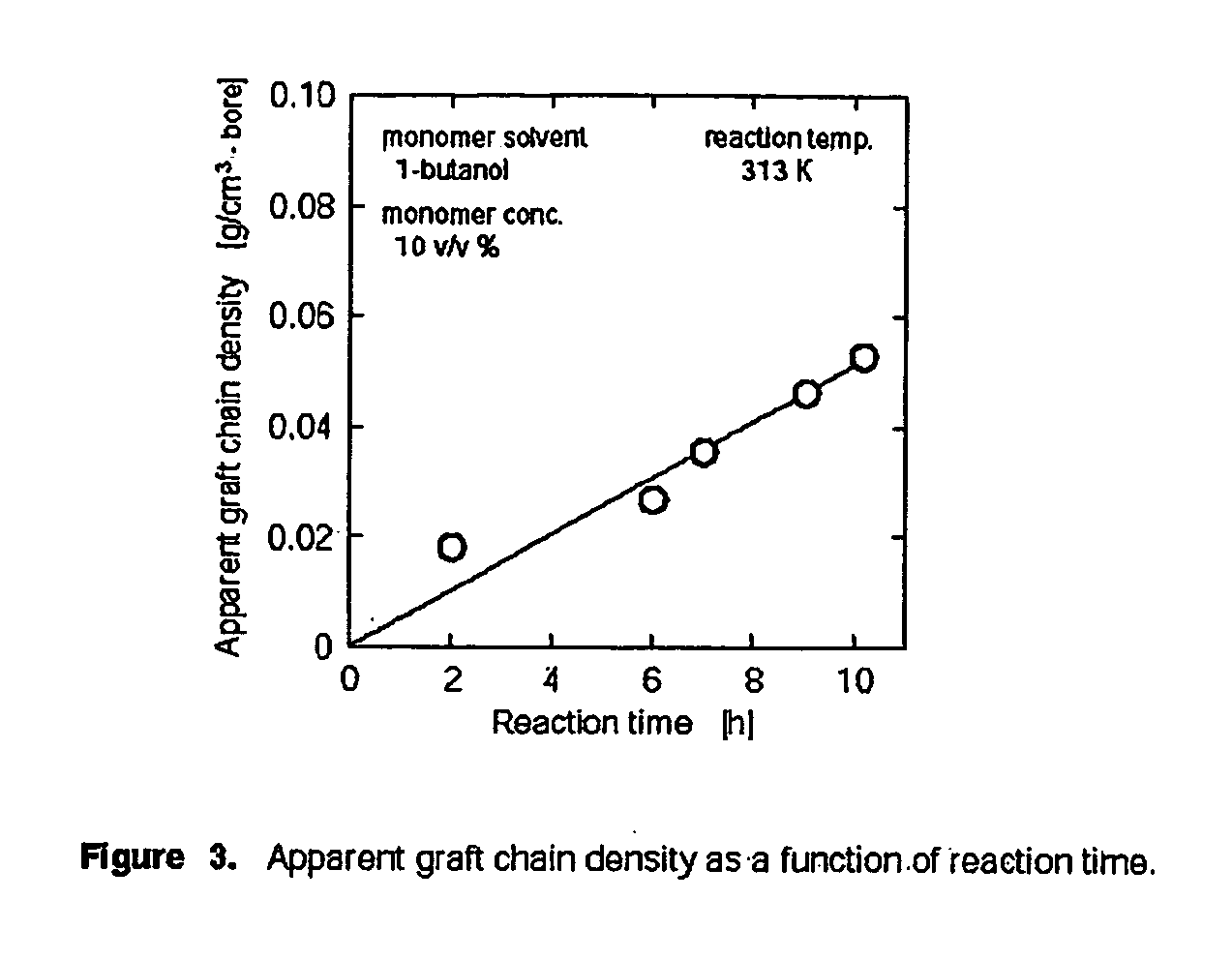Functionalized materials and methods of using same
a technology of functionalized materials and materials, applied in the field of material for the separation, purification, concentration, immobilization and synthesis of compounds, can solve the problem that such methods do not have a broad application, and achieve the effect of reducing the concentration of molecules
- Summary
- Abstract
- Description
- Claims
- Application Information
AI Technical Summary
Benefits of technology
Problems solved by technology
Method used
Image
Examples
example one
Preparation of Membrane Compositions for the Immobilization of Ascorbic Acid Oxidase
[0084] A base material comprising a porous membrane in a hollow-fiber form was used as a trunk polymer for grafting. This hollow fiber, made of polyethylene, had inner and outer diameters of 1.8 and 3.1 mm, respectively, with an average pore size of 0.4 microns and porosity of 70%. The reactive monomer, glycidyl methacrylate (GMA, CH2═CCH3COOCH2CHOCH2) was purchased from Tokyo Kasei Co., Ltd., and used without further purification. A preparation scheme of porous hollow-fiber membrane compositions containing a diethylamino (DEA) group as an anion-exchange group consists of four steps. (1) Irradiation of an electron beam onto the trunk polymer to form radicals: the polyethylene porous hollow-fiber membrane was irradiated by an electron beam in a nitrogen atmosphere at ambient temperature using a cascade-type accelerator (Dynamitron model IEA 3000-25-2, Radiation Dynamics Inc., New York). The dose was ...
example two
Preparation of Membrane Compositions for the Immobilization of Aminoacylase
[0090] A commercially available porous hollow-fiber membrane, supplied by Asahi Chemical Industry Co. (Tokyo, Japan), was used as a trunk polymer for grafting. This hollow fiber had inner and outer diameters of 1.2 and 2.2 mm, respectively, with an average pore diameter of 0.24 microns and a porosity of 70%. Aminoacylase was purchased from Sigma Co. (No.3333). Glycidyl methacrylate (CH2═CCH3COOCH2CHOCH2) was obtained from Tokyo Chemical Co., and was used without further purification. Other chemicals were of analytical grade or higher. An anion-exchange porous membrane with a hollow-fiber form was prepared by radiation-induced graft polymerization and subsequent chemical modifications (J. Chromatogr. A., 689:211-218, 1995, incorporated by reference). The trunk polymer was irradiated with an electron beam at a dose of 200 kGy and immersed in 10 (v / v)% glycidyl methacrylate(GMA) / methanol solution at 313 K for 1...
example three
Functionalized Polymeric Tools
[0098] Grafting of poly-GMA Brushes onto Plastic Pipet Tips
[0099] A container of the present invention includes a functionalized pipet tip. Commercially available pipette tips were purchased from Eppendorf-Netheler-Hinz GmbH (Standartips 300 μL). The pipette tips were made of polypropylene. Pipette tips were set in a polyethylene package which was subsequently sealed with N2. Electron beam irradiation was performed at ambient temperature by means of a cascade electron accelerator (Dynamitron IEA-3000-25-2, Radiation Dynamics, Inc.) operated at a voltage of 2 MeV and a current of 1 mA. The conveyer on which the polyethylene fibers were mounted was reciprocated at a speed of 3.8 cm / s. The irradiation dose per passage of the conveyer was 10 kGy. The exposed total irradiation dose of electron beam was set at 50, 100, 150, or 200 kGy. After irradiation the fibers were immersed in a GMA solution (10 vol / vol % in methanol or butanol) previously deaerated by ...
PUM
| Property | Measurement | Unit |
|---|---|---|
| Mass | aaaaa | aaaaa |
| Fraction | aaaaa | aaaaa |
| Percent by mass | aaaaa | aaaaa |
Abstract
Description
Claims
Application Information
 Login to View More
Login to View More - R&D
- Intellectual Property
- Life Sciences
- Materials
- Tech Scout
- Unparalleled Data Quality
- Higher Quality Content
- 60% Fewer Hallucinations
Browse by: Latest US Patents, China's latest patents, Technical Efficacy Thesaurus, Application Domain, Technology Topic, Popular Technical Reports.
© 2025 PatSnap. All rights reserved.Legal|Privacy policy|Modern Slavery Act Transparency Statement|Sitemap|About US| Contact US: help@patsnap.com



